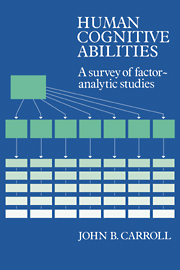Book contents
- Frontmatter
- Contents
- Preface
- PART I INTRODUCTION TO THE SURVEY
- PART II THE IDENTIFICATION AND DESCRIPTION OF COGNITIVE ABILITIES
- Chapter 5 Abilities in the Domain of Language
- Chapter 6 Abilities in the Domain of Reasoning
- Chapter 7 Abilities in the Domain of Memory and Learning
- Chapter 8 Abilities in the Domain of Visual Perception
- Chapter 9 Abilities in the Domain of Auditory Reception
- Chapter 10 Abilities in the Domain of Idea Production
- Chapter 11 Abilities in the Domain of Cognitive Speed
- Chapter 12 Abilities in the Domain of Knowledge and Achievement
- Chapter 13 Psychomotor Abilities
- Chapter 14 Miscellaneous Domains of Ability and Personal Characteristics
- Chapter 15 Higher-Order Factors of Cognitive Ability
- PART III ISSUES
- References and List of Datasets
- Appendix A Codes for Countries, Samples, and Factors
- Appendix B Hierarchical Factor Matrix Files
- Name Index
- Subject Index
Chapter 8 - Abilities in the Domain of Visual Perception
Published online by Cambridge University Press: 29 September 2009
- Frontmatter
- Contents
- Preface
- PART I INTRODUCTION TO THE SURVEY
- PART II THE IDENTIFICATION AND DESCRIPTION OF COGNITIVE ABILITIES
- Chapter 5 Abilities in the Domain of Language
- Chapter 6 Abilities in the Domain of Reasoning
- Chapter 7 Abilities in the Domain of Memory and Learning
- Chapter 8 Abilities in the Domain of Visual Perception
- Chapter 9 Abilities in the Domain of Auditory Reception
- Chapter 10 Abilities in the Domain of Idea Production
- Chapter 11 Abilities in the Domain of Cognitive Speed
- Chapter 12 Abilities in the Domain of Knowledge and Achievement
- Chapter 13 Psychomotor Abilities
- Chapter 14 Miscellaneous Domains of Ability and Personal Characteristics
- Chapter 15 Higher-Order Factors of Cognitive Ability
- PART III ISSUES
- References and List of Datasets
- Appendix A Codes for Countries, Samples, and Factors
- Appendix B Hierarchical Factor Matrix Files
- Name Index
- Subject Index
Summary
Spatial ability has been defined in such a variety of different ways that it is often difficult to be precise about the meanings which we ascribe to the term.
John Eliot & Ian MacFarlane Smith (1983)Abilities in visual perception have received much attention in psychometric studies. Over the years since Spearman first announced the identification of a general factor in intelligence, a number of separate abilities in the realm of visual perception, to some extent independent of general intelligence, have come to be recognized, but research studies have often led to contradictory and confusing conclusions about exactly what abilities exist and how they should be defined and measured. Often these abilities have been discussed under the heading of “spatial ability,” because at least some of them have to do with how individuals deal with materials presented in space – whether in one, two or three dimensions, or with how individuals orient themselves in space. Dimensionality is, of course, an inherent attribute of space as commonly perceived, but it may not be the central attribute that is of concern in spatial ability or visual perception in general. What appears to be of more concern is the fact that objects, forms, or symbols are perceived as laid out in the space presented to the eyes (or in the “mind's eye,” imaginal memory), whether in real-life interactions between the individual and his or her surroundings or in pictorial or printed representations of forms, objects, or text on paper.
- Type
- Chapter
- Information
- Human Cognitive AbilitiesA Survey of Factor-Analytic Studies, pp. 304 - 363Publisher: Cambridge University PressPrint publication year: 1993
- 10
- Cited by



